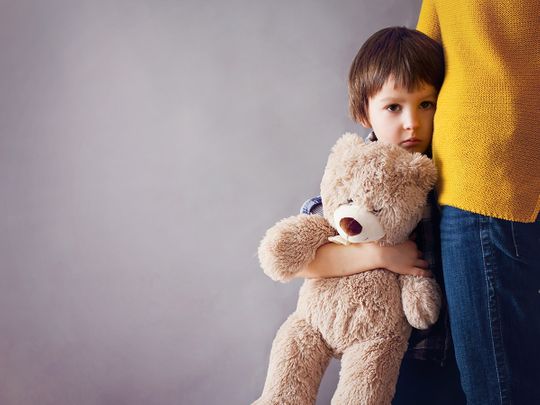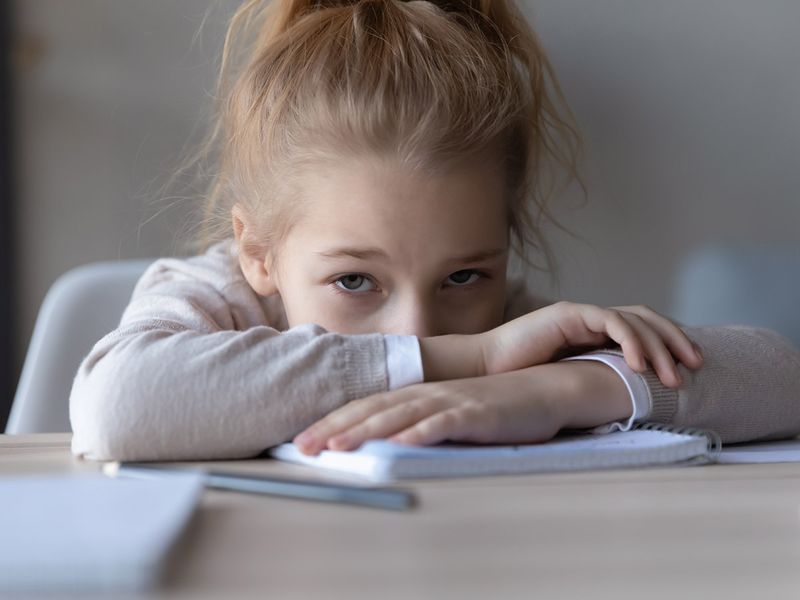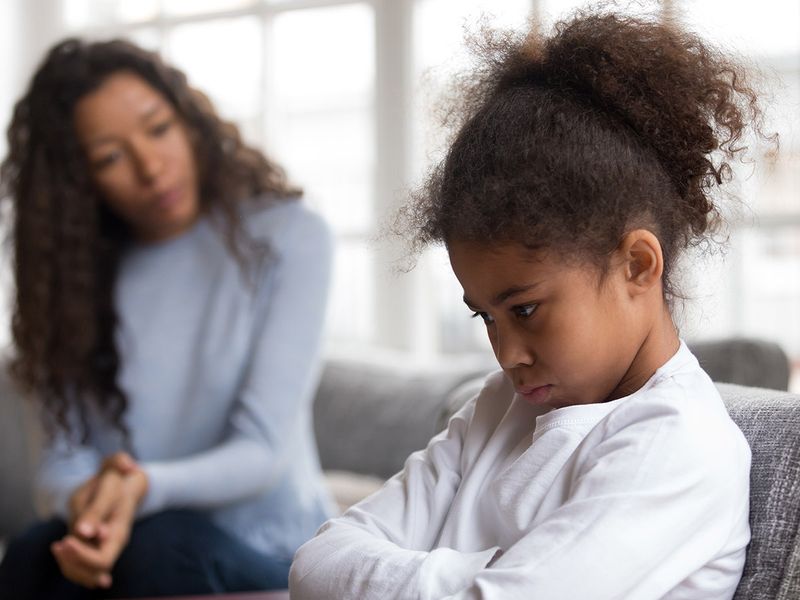
Dubai: Tiny fists, tightened up, big eyes, welling with tears … seeing your little one feel sad can be extremely hard for a parent. Whether it is a toy that broke, a toe they bumped or a friend’s party they couldn’t attend - wanting to shield children from negative emotions can almost feel like a duty for parents. But if experts are to be believed, letting your child feel those emotions can help them grow up to be happier adults.
Feeling sad is not all that bad
According to Rima Abboud, Child and Adult Clinical Psychologist at Wise Mind Psychotherapy Centre in Dubai, negative emotions are not an unwanted part of a child’s life. In fact, they can be helpful indicators of what is going on in their body or in their mind.

“A lot of times we feel that emotions are the things that we need to repress or get rid of very quickly. But emotions – positive or negative – are not necessarily a bad thing, they are indicators to our body that something is up,” Abboud told Gulf News.
“The feeling of sadness or being upset is our body’s way of saying that something is up – the child is perhaps hurt or they couldn’t get something they wanted. There’s something that they need … that’s the function that feeling serves,” she added.
Also, allowing children to express these emotions is extremely important. While children struggle with moderation, it is important to not force them to not show emotion at all.

A lot of times we feel that emotions are the things that we need to repress or get rid of very quickly. But emotions – positive or negative – are not necessarily a bad thing, they are indicators to our body that something is up
Abboud spoke about how parents may sometimes criticise children because they are jumping too much out of joy, or are crying too loudly because of a toy they could not play with. It is important to not shut down those expressions altogether, but rather help children develop coping mechanisms.
“Rarely is the emotion the problem, but because the mode of expression is either problematic or too loud, it is seen as a problem. When that happens, sometimes we, too, struggle to regulate our own emotions, let alone support our child in regulating themselves,” she said.
The clear red lines
Saeeda Almarzooqi, a Dubai-based psychologist, also spoke about two extreme approaches that parents might adopt – permissive versus tough love.
“Some people will say - I need to protect my child, not allow them to feel sad or upset. For example, a lot of parents will adhere to a child’s request. If the child says, ‘I want to watch TV for another hour’, they will give in if the child starts crying. But another approach also exists among parents –‘let them cry, because we want them to be stronger in the future’. The problem, though, is that parents may not see the limit of what type of negative experiences we should let them have. This is especially true when it comes to boys, unfortunately,” Saeeda said.
What she does recommend, is finding the sweet spot in between these two approaches. A Goldilocks’ approach to addressing incidents that lead to sadness in your child’s life.
There are some approaches that are clearly to be avoided, according to Saeeda.
“Hitting, physical punishment, yelling, threatening, making fun of children in front of others, all from the aspect of ‘I want to toughen them up because life is not easy’ is a clear no-no. There is enough research that has clearly shown that there is no good that comes out of this approach.
“Unfortunately, a lot of parents don’t see it from that aspect. They think that since they were yelled at by their parents, or made fun of, they are doing a good job of parenting now. But when we dig deeper, they may have issues with their marriage, career, or with emotional regulation,” Saeeda said.

Why do we have these emotions? The negative emotions are just as normal as the positive emotions like. Letting them feel these emotions is part of their development, and it is linked to their cognitive and physiological development.
Feeling blue: What is going on in a child’s mind?
Big feelings like anger, frustration, jealousy, anxiety, sadness, and stress can be overwhelming for children. Without warning, their body is flooded with physical sensations – racing heart, tense muscles, sweat, tingling fingers.
When it comes to emotions, it turns out that there are regions in the brain, specifically in the limbic system, that are associated with each of the six main emotions – happiness, anger, sadness, fear, surprise, and disgust. The limbic system is the part of the brain involved in our behavioural and emotional responses.
Understanding exactly what is going on in your child’s mind when they are experiencing sadness can help you, as a parent, deal with the incidents more calmly and effectively. Dr Ahmad Hammoud, a Dubai-based consultant paediatric neurologist, spoke to Gulf News about how researchers have used different techniques to understand the neurological reality when a person feels emotions, like sadness.
“Functional Magnetic Resonance Imaging (fMRI), Positron Emission Tomography (PET) and intracranial Electroencephalography (EEG) are valuable techniques for measuring emotions in the brain. While fMRI provides information about regional brain activation, PET offers insights into neurochemical changes associated with emotions. Intracranial EEG will show the brain activity in response to specific emotions and its relation to specific areas of the brain,” Dr Hammoud said.
“By examining activity patterns in these regions, researchers can identify brain networks associated with specific emotional states. For example, increased amygdala activation has been linked to fear and threat processing, while activity in the prefrontal cortex has been connected with emotional regulation,” Dr Hammoud said.
So, what do the studies show?
A 2018 study published in the US-based science journal Cell looked at the EEG processing of sad faces, which showed an increased activation in parts of the brain that are responsible for not just regulating empathy and social cognition but also object recognition and perception, as well as identifying and recognising words.

By examining activity patterns in these regions, researchers can identify brain networks associated with specific emotional states. For example, increased amygdala activation has been linked to fear and threat processing, while activity in the prefrontal cortex has been connected with emotional regulation.
Another study, published in 2020, titled ‘The neuroscience of sadness’ looked at sadness in adults and found that it involves reduction of cortical control. The prefrontal cortex is the one that helps human beings use reason and logic in making decisions. When it comes to children, this part of the brain is still developing. So, the feeling of sadness can be harder to work with.
This may be the reason why giving children a logical analysis of their mistake, when they are feeling upset, might not have the effect you are looking for.
Instead, the study found that evolutionarily ancient brain systems, like the amygdala gain more control. This is the part of the brain that is involved in regulating fear and anger. When a person feels stressed or afraid, the amygdala releases stress hormones that prepare the body to fight the threat or flee from the danger, referred to as the ‘fight or flight’ phenomenon.
How can parents help? Follow this three-step approach

Step 1: Help children identify the emotion they are feeling
Depending on how old the child is, he or she may be able to use words to put a name to the feeling there are experiencing.
For children too young to speak, Abboud suggests using an expressions wheel - imagine a bunch of emojis on a circle … six emojis for the six basic emotions – sadness, happiness, fear, anger, surprise and disgust.
“In time, children learn to communicate those emotions into words. This is a very important tool in understanding and learning to communicate, in general. We are not necessarily trying to teach children not to feel a certain way but rather to understand the emotion, verbalise it and communicate it,” Abboud said.
Step 2: Validate their experience, but maintain the rules
Saeeda advised parents to give children their space, to allow them to calm down, but also not give in and bend clearly established rules at home.
“For example, if my daughter is upset that I did not allow her to watch TV for another hour, I will just listen to her. I will tell her I know you are upset because I switched off the TV, when you feel a bit calm we’ll talk. I give her the space. While we have a rule that we don’t watch TV for longer than the time we have decided on, she is still upset. For me it might be a stupid reason but for her it is real and painful. But just giving them that space works like magic – she goes into a corner, cries if she wants to cry. But throughout this process, I will remind her that she is not a bad girl and that I am not annoyed by her. Ultimately, she calms down and I also make sure I do not change the rule we have established,” she said.
“I am not upset by you I am not upset by your action. I still love you as my daughter I am just upset by the action. Interestingly she will confirm that with me – ‘You still love me right?’.”
Step 3: Offer support
Words to use: “How can I help you?”, “What can we do to make the feeling better?”
The goal, according to Abboud, is not to necessarily solve the problem the child is facing, but to support them in dealing with the emotion in any way they choose to deal with it.
“Sometimes it is okay to just cry it out. They need to know that their mum, dad and siblings are there, and that’s enough. At other times, they might want to do something on their own. Let them live through that emotion, not to be afraid of it. Then, you can look at solving the problem that caused the emotion of sadness,” Abboud said.
“Gradually as you go through the process again and again, the emotions are going to get less acute,” she added.
5 coping strategies to work on with children
1. Deep breathing – it helps de-escalate the anxiety or stress.
Saeeda advises parents to practise deep breathing in advance as it will be easier to put into action at the time of distress.
“At the time when they are upset, it is a nice reminder – ‘Remember what we spoke about?’”
While counting inhales and exhales can work with older children, with younger children, you can use a more descriptive instruction. Saeeda recommends using the image of a balloon in the child’s tummy
“You could say something like, ‘Imagine you are putting air in your tummy … there is a balloon in your tummy. Now take a deep breath and fill it in. Remember to put the air in the tummy, not the chest’. Once they breathe in, say, ‘Yalla, let’s empty the balloon now’ and ask them to exhale as if they are blowing a candle,” she said
2. Create a rating system
An easy way to help children identify just how sad they are feeling is to ask them to tell you by putting a number to their feeling.
3. Mindfulness
When it comes to older children, aged eight years and older, helping them connect with what they are doing at the moment can also help reduce feelings of sadness.
4. Imagery
“Imagine something you like … a scene or an object or someone you like. How does it make you feel? Nice? Calm? By having a conversation with children and asking them to embed that feeling of peace, instead of sadness, can be another coping strategy,” Saeeda said.
5. Muscle relaxation techniques
“Another strategy which needs a lot of practice is to squeeze your hand into a fist, as if you have a ball in your hand and then release. Another exercise could be to touch your nose or stretch your arms like a cat. This helps to reduce the level of the emotions they are feeling. Our emotions and our bodies are interconnected,” Saeeda said.
Finally, she asked parents to remember to regulate their own emotions, before they start helping their child regulate theirs.
“You have to allow children to be sad. You are not changing the rule, and you are letting them know that actions have consequences. But remember, a beautiful hug will be nice, too. If you are upset with them, it doesn’t mean that you do not hug them,” she said.
Building more resilient, empathetic adults
Abboud said that children who go through this process of experiencing stressors that cause sadness and then are able to identify it, understand what their body is telling them, and then be able to work through that feeling would more likely grow up to be well-adjusted adults.
“It also helps develop more social skills because they are able to understand other people’s emotions, too. Self-awareness, however, is one of the greatest benefits of such an approach along with the skill to regulate emotions. This is because there will be a lot of stressors in their life as they grow up – being able to cope with difficult emotions is extremely helpful,” Abboud said.





